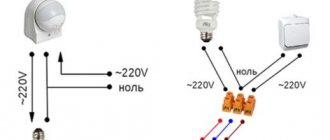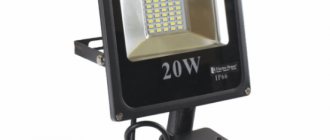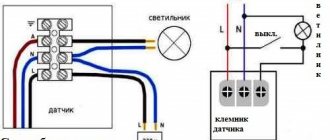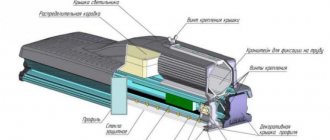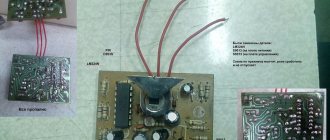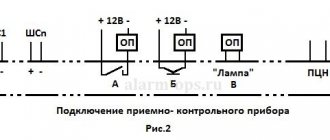Basic information about the motion sensor
Let's look at some information about the motion sensor for lighting and its scope. A motion sensor is a device whose main function is to detect movement in its coverage area. There are three types of sensors - passive, active and mixed.
The operating principle of the active sensor is based on the radiation of ultrasonic and electromagnetic waves. Passive, has an infrared sensor that detects human heat. Mixed motion sensors have both control devices.
Types of motion sensors
The main task of a motion sensor is to record movement in a given area. As soon as an object crosses the specified line, or takes a location in the area covered by the sensor, the sensor will perceive this phenomenon and transmit the corresponding signal. In everyday life, today, there is a fairly large variety of such devices, differing both in functionality and principle of operation:
- infrared - based on the principle of changing the state of an electronic key under the influence of light radiation;
- radio waves - send a certain frequency of radio waves to a given area; if an obstacle appears, the waves are reflected and the antenna perceives this radiation, sending a corresponding signal in response;
- thermal - react to the appearance of objects with a certain temperature in the coverage area, suitable for use indoors or after sunset;
- magnetic - they are an analogue of a button installed on a door or gate, they are triggered when opened, this type of sensor has significant limitations in operation;
Thermal motion sensors will fail when installed in the kitchen near heaters and other heat sources. The radio wave sensor is similarly afraid of interference. Therefore, infrared devices that operate using a photo relay that changes the level of resistance when hit by light waves have become widespread. The simplest and most understandable to manufacture would be an infrared motion sensor.
How the device works
Active sensors, by recording and comparing data received during radiation, alert movement if there is a shift in the data.
Advantages of ultrasonic sensors:
- Low cost.
- Unaffected by weather conditions.
- Recognize movement regardless of the material.
Disadvantages of ultrasonic devices:
- Range limitation
- They are designed for fairly sudden movements.
- Animals are sensitive to ultrafrequencies.
Most often, such devices are used in car security systems.
Pros of RF motion sensors:
- Their sizes are small.
- Long range models are available.
- Very accurate.
Disadvantages of radio frequency devices:
- Their cost is quite high.
- Due to the high sensitivity threshold, false motion detections occur.
- The high power of the device can have a bad effect on the human or animal body if left in the field for a long time.
Kinds
Motion controllers are classified according to the emission frequencies they can detect. In particular, there are sensors that work on:
- ultrasonic radiation;
- infrared radiation (IR);
- microwave radiation.
There are also combined devices. They combine sensors that record movement using fundamentally different sensors. For example, thermal and acoustic devices.
Ultrasonic alarm
The operating principle of such sensors is based on the effect of wave reflection. An oscillation generator is installed inside this device, which emits signals with a frequency of 20-60 kHz. These signals propagate in the environment, are reflected from objects and return. If a wave detects movement, its frequency changes; the sensor detects this, activating the connected system.
Ultrasonic sensors come in the following types:
- Wall-mounted external and internal.
- Ceiling.
- Angular.
Select one of the types of controllers depending on the installation location of the device. Moreover, outdoor models of controllers are equipped with special protective cases to increase operating time.
Ultrasonic sensors can operate in any weather conditions.
Infrared devices
Infrared controllers work as follows: the sensor compares the temperature of the object with a reference temperature. If the temperature difference is higher than or equal to a certain level, the controller activates the system.
For example, the background temperature level is 20 °C. A person enters a room emitting an average of 36.6 °C. The difference is 16.6 °C. If the sensor is programmed to a lower activation level, it will operate and start the system that is connected to it.
The main thing is to configure the controller correctly.
If it is too sensitive, it will react to the slightest changes in temperature (hot air flows). In this case, false alarms cannot be avoided, therefore, the operation of the sensor will be partially
Microwave sensors
The operating principle of a microwave controller is similar to an ultrasonic one, only the electromagnetic field is generated at a higher frequency. True, such a sensor reacts to any movements, and not just those made by objects heated to a certain level. The main condition is that they must reflect waves and not absorb them (although a reflected wave is always present without exception due to the imperfection of technical devices).
Combined devices
Such controllers combine two sensors that differ in their operating principles. For example, temperature and audio sensors. It is important that one motion detection technology is complemented by another. That is, the accuracy of such a sensor is much higher.
A noise sensor can detect the presence of a person in a room, and an infrared sensor paired with it will support the operation of the system connected to it.
The combined sensor does not need to see the person or object. He can hear it and this is enough to activate the operation of devices connected to the controller.
It is advisable to use such controllers in cottages, on staircases, where there are “blind spots”.
They are used in security systems
Passive devices have infrared sensors that monitor the temperature within their range. When the temperature data changes, the device is triggered. This type of device is used more often for lighting in residential areas.
IR sensor device
Pros of an infrared sensor
- They are safe for people and animals.
- They can be easily customized.
- They work great both indoors and outdoors.
- The price is satisfactory.
Disadvantages of an infrared sensor
- Such a device only works within certain temperature limits.
- It does not pick up objects coated with infrared blocking material.
- The device malfunctions when exposed to heat flows from heaters and warm wind.
Assembly works, work in stages
The motion sensor circuit for lighting is very simple. For those who have been involved in the repair of electrical appliances, this will not be difficult to do.
Stages of work:
- To get started, you should prepare the power supply. The connector should be cut off. Then use a voltmeter to find the plus.
- Then you should solder a 10 kohm resistor.
- The photodiode cathode must be soldered to a resistor, which is soldered to the positive.
- By soldering, we connect the photodiode anode to the construction resistor. The emitter of the transistor should be soldered to the negative of the resistor. The required collector is connected to the VT 1 base, which is soldered to R1.
- Then the emitter of VT 2 should be connected to the minus, the relay contact should be connected to the collector of VT 2. Another relay contact should be soldered to the plus of the power supply.
- The most common is the use of a laser pointer, and that’s what we use. To save money, we also solder two additional wires to the power supply.
- We insert the cord into the plumbing gasket, with the cap inside, insert it into the pointer - so that the cap rests on the spring inside.
- One wire from the power supply should be connected to the screw, and the other should be inserted between the gasket and the body of the pointer.
Before turning on, you should check the diagram again. If everything matches the diagram, then we check the operation of the device.
How to connect the device and adjust sensitivity
In order for the device to work properly and cope with the task, you need to take a responsible approach to its installation. The best place for installation is the doorway. For a more aesthetic appearance, the device can be placed in a plastic box by making a hole for the photodiode.
Mounts the sensor at a height of about a meter, from the floor. The pointer should be installed parallel to the floor and so that the beam hits the photodiode, then the sensitivity during operation of the device will not be impaired, and there will be no need to resort to repairing it.
After installation is complete, you can hide the wires, so they will not spoil the appearance or get tangled underfoot. It is advisable to think about installing the device during renovations in the room, then it will be easier to hide the wires connecting to the lighting. When making repairs, it is easier to think about the location of the device.
In order for the sensitivity to be good, you need to ensure that the pointer is installed correctly. If it is installed correctly, then the sensitivity will be normal, and the device will not malfunction and will not need to be repaired.
When installing, remember that if the photodiode is dirty or the pointer beam is obstructed, the operation of the device may be impaired.
Motion sensor circuits
The principle of operation of a motion sensor is based on the readings of a measuring element that records changes in a certain parameter in the environment. As a sensing element, we will consider a pyromodule (PIR element) or a photoresistor, which will respond to changes in infrared radiation. The simplest diagram of such a sensor is:
Rice. 1. Sensor diagram on the pyromodule
As you can see in Figure 1, the PIR D203S pyromodule includes several elements:
- the PIR pyroelectric itself;
- field effect transistor T1;
- shunt resistor R1.
The circuit works as follows: when light hits the PIR sensor, it changes the electrical parameter and opens the circuit for current to flow through the load. This is the simplest sensor option for a motion sensor; instead, you can use the domestic model PM-4. Connecting the latter will be a little more complicated and will require separate installation of some radio components. The connection diagram for the PM-4 sensor is shown in the figure below:
Rice. 2. Connecting the PM-4 sensor
This PIR element model, unlike the previous one, has eight pins, 5 of which we will need for connection. As you can see in Diagram 2, the connection occurs as follows:
- pins 1,6 and 8 must be combined to connect to the negative bus;
- terminal 8 is connected to terminal 2 via resistor R1;
- pin 2 is connected to the gate of transistor VT1;
- terminal 4 of the sensor is connected to the source of transistor VT1.
The load or working electrical appliance is connected to the drain of the semiconductor element. PM-4 is much more common among radio amateurs, so it is easier to find as a handy assistant. But in the absence of such, an ordinary bipolar transistor will help to get out of the situation if you remove the top cover from it to open light access to the silicon crystal. In this case, based on it, you can also assemble a motion sensor with your own hands; the working diagram of such a sensor is shown in Figure 3 below:
Rice. 3. Transistor-based motion sensor circuit
Since the adjustment of the open and closed positions in the motion sensor will be carried out due to the light flux incident on the crystal, the base is removed and does not participate in the operation of the circuit. The rest of the scheme will work according to this principle:
- when light hits the open crystal of transistor VT1, it will open and current will flow through its circuit and amplifier DA1 to the load;
- if the supply of light to VT1 is stopped, the junction will close and the voltage at point A will go to zero, capacitor C1 will begin to discharge;
- power supply to the load will stop due to the closure of the phototransistor, and resumption will occur only after the barrier between the light source and the receiver leaves the specified area;
Rice. 4. Obstacle between source and receiver
- You can connect a relay or contactor to the output of the motion sensor, which will control turning the spotlight on or off.
In the diagram, R1 together with capacitor C1 represent a timing chain, so the result of switching on the load will depend on their parameters. In our example, the most common connection is lighting from a motion sensor. An adjustable resistor R2 is installed in the feedback circuit of the amplifier, and the higher its value, the more efficient the amplification, but the stability of the entire circuit decreases. Therefore, the selection of these three elements must be done experimentally; the figure above shows only approximate parameters.
